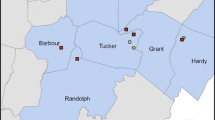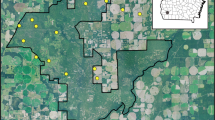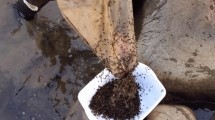Abstract
Low food availability and forage quality and concomitant decreased lipid reserves of lesser scaup (Aythya affinis; hereafter scaup) during spring migration in the upper Midwest may partially explain reductions in the continental population of scaup. In springs 2004–2005, we examined wetland use and feeding activity of scaup on 356 randomly-selected wetlands within 6 regions in Iowa, Minnesota, and North Dakota. We examined wetland characteristics that favor high scaup use in 286 of these wetlands. We found that probabilities of wetland use and feeding by scaup increased with turbidity up to 45 and 30 NTU, respectively, but then declined at higher turbidity levels. Wetland use was positively correlated with size of open-water zone and amphipod densities, but was not correlated with chironomid densities. Feeding increased with amphipod density up to 26 m−3 and then declined at higher amphipod densities; scaup seemingly forage most efficiently at amphipod densities above 26 m−3. Wetland use was higher in North Dakota than in southern Minnesota and Iowa. Our results indicate that effective wetland restoration efforts to benefit scaup require maintaining abundant populations of amphipods (generally near 26 m−3 landscape geometric mean) in wetlands with large (> 500 m diameter) open-water zones throughout the upper Midwest, but especially within Iowa and southern Minnesota.
Similar content being viewed by others
Literature Cited
Afton, A. D. 2008. Chronology and rates of migratory movements, migration corridors and habitats used, and breeding and wintering area affiliations of female lesser scaup captured during spring stop-over on Pool 19 of the Mississippi River. Online resource: http://www.ducks.org/Conservation/ScaupResearchProject/3161/ScaupResearchProjectHome.html.
Afton, A. D. and M. G. Anderson. 2001. Declining scaup populations: a retrospective analysis of long-term population and harvest survey data. Journal of Wildlife Management 65: 781–96.
Afton, A. D. and R. H. Hier. 1991. Diets of lesser scaup breeding in Manitoba. Journal of Field Ornithology 62: 325–34.
Afton, A. D., R. H. Hier, and S. L. Paulus. 1991. Scaup diets during migration and winter in the Mississippi Flyway. Canadian Journal of Zoology 69: 328–33.
Anteau, M. J. 2006. Ecology of lesser scaup and amphipods in the upper-Midwest: scope and mechanisms of the spring condition hypothesis and implications for migration habitat conservation. Ph.D. Dissertation. Louisiana State University, Baton Rouge, LA, USA. http://etd.lsu.edu/docs/available/etd-01242006-093828
Anteau, M. J. and A. D. Afton. 2004. Nutrient reserves of lesser scaup (Aythya affinis) during spring migration in the Mississippi Flyway: A test of the spring condition hypothesis. Auk 121: 917–29.
Anteau, M. J. and A. D. Afton. 2006. Diet shifts of lesser scaup are consistent with the spring condition hypothesis. Canadian Journal of Zoology 84: 779–86.
Anteau, M. J. and A. D. Afton. 2008a. Amphipod densities and indices of wetland quality across the upper-Midwest, USA. Wetlands 28: 184–96.
Anteau, M. J. and A. D. Afton. 2008b. Diets of lesser scaup during spring migration throughout the upper-Midwest are consistent with the spring condition hypothesis. Waterbirds 31: 97–106.
Austin, J. E., C. M. Custer, and A. D. Afton. 1998. Lesser scaup (Aythya affinis). The Birds of North America, Number 338. The American Ornithologists’ Union, Washington, D. C., USA, and the Academy of Natural Sciences, Philadelphia, PA, USA.
Badzinski, S. S. and S. A. Petrie. 2006. Lesser scaup nutrient reserve dynamics during spring on the Lower Great Lakes. Wildlife Society Bulletin 34: 395–407.
Bartonek, J. C. and J. J. Hickey. 1969. Food habits of canvasbacks, redheads, and lesser scaup in Manitoba. Condor 71: 280–90.
Bellrose, F. C. 1980. Ducks Geese and Swans. Stackpole Books, Harrisburg, PA, USA.
Besser, J. M., W. G. Brumbaugh, N. E. Kemble, T. W. May, and C. G. Ingersoll. 2004. Effects of sediment characteristics on the toxicity of chromium (III) and chromium (IV) to the amphipod Hyalella azteca. Environmental Science and Technology 38: 6210–16.
Dahl, T. E. 1990. Wetland loss in the United States, 1780’s to 1980’s, p. 21. U.S. Fish and Wildlife Service, Washington, D.C., USA.
Ducks Unlimited Inc. 2004. Living Lakes Initiative Plan. Ducks Unlimited Inc., Great Plains Regional Office, Bismarck, ND, USA.
Euliss, N. H., Jr., J. W. LaBaugh, L. H. Fredrickson, D. M. Mushet, M. K. Laubhan, G. A. Swanson, T. C. Winter, D. O. Rosenberry, and R. D. Nelson. 2004. The wetland continuum: a conceptual framework for interpreting biological studies. Wetlands 24: 448–58.
Euliss, H. H., Jr., L. M. Smith, D. A. Wilcox, and B. A. Browne. 2008. Linking ecosystem processes with wetland management goals: charting a course for a sustainable future. Wetlands 28: 553–62.
Fast, P. L., R. G. Clark, R. W. Brook, and J. E. Hines. 2004. Patterns of wetland use by brood-rearing lesser scaup in northern boreal forest of Canada. Waterbirds 27: 177–12.
Gleason, R. A., N. E. Euliss, Jr., D. E. Hubbard, and W. G. Duffy. 2003. Effects of sediment load on emergence of aquatic invertebrates and plants from wetland soil egg and seed banks. Wetlands 23: 26–34.
Gleason, R. A., M. K. Laubhan, and N. H. Euliss, Jr. 2008. Ecosystem services derived from wetland conservation practices in the United States and prairie pothole region with and emphasis on the U.S. Department of Agriculture Conservation Reserve and Wetlands Reserve programs. Professional Paper 1745. U.S. Geological Survey, Reston, VA, USA.
Grue, C. E., M. W. Tome, G. A. Swanson, S. M. Borthwick, and L. R. DeWeese. 1988. Agricultural chemicals and the quality of prairie-pothole wetlands for adult and juvenile waterfowl — what are the concerns? p. 55–64. In P. J. Stuber (ed.) Proceedings National Symposium of Protection of Wetlands from Agricultural Impacts. U.S. Department of Interior, U.S. Fish and Wildlife Service, Biological Report 88(16).
Johnson, R. R. and K. F. Higgins. 1997. Wetland resources of eastern South Dakota. South Dakota State University, Brookings, SD, USA. http://www.npwrc.usgs.gov/resource/wetlands/sdwet/sdwet.htm
Kantrud, H. A., G. L. Krapu, and G. A. Swanson. 1989. Prairie basin wetlands of North Dakota: a community profile. Biological report 85(7.28), U.S. Department of the Interior, Fish and Wildlife Service, Research and Development, Washington, DC, USA.
Kahl, R. 1991. Boating disturbance of Canvasbacks during migration at Lake Poygan, Wisconsin. Wildlife Society Bulletin 19: 242–49.
Korschgen, C. E., L. S. George, and W. L. Green. 1985. Disturbance of diving ducks by boaters on a migrational staging area. Wildlife Society Bulletin 13: 290–96.
Lindeman, D. H. and R. G. Clark. 1999. Amphipods, land-use impacts, and lesser scaup (Aythya affinis) distribution in Saskatchewan wetlands. Wetlands 19: 627–38.
Low, J. B. 1941. Spring flight of diving ducks through northwestern Iowa. Condor 43: 142–51.
Murkin, H. R. and L. C. M. Ross. 2000. Invertebrates in prairie wetlands. p. 201–48. In H. R. Murkin, A. G. van der Valk, and W. R. Clark (eds.) Prairie Wetland Ecology: The Contribution of the Marsh Ecology Research Program. Iowa State University Press, Ames, IA, USA.
Rogers, J. P. and L. J. Korschgen. 1966. Foods of lesser scaups on breeding, migration, and wintering areas. Journal of Wildlife Management 30: 258–64.
SAS Institute. 2002. SAS/STAT user’s guide, version 9. SAS Institute, Cary, NC, USA.
Strand, K. A. 2005. Diet and body composition of migrating lesser scaup (Aythya affinis) in Eastern South Dakota. M.S. Thesis. South Dakota State University, Brookings, SD, USA.
Strand, K. A., S. R. Chipps, S. N. Kahara, K. F. Higgins, and S. Vaa. 2008. Pattern of prey use by lesser scaup Aythya affinis (Aves) and diet overlap with fishes during spring migration. Hydrobiologia 598: 389–98.
Swanson, G. A. and H. F. Duebbert. 1989. Wetland habitats of waterfowl in the prairie pothole region. p. 228–67. In A. G. van der Valk (ed.) Northern Prairie Wetlands. Iowa State University Press, Ames, IA, USA.
Swanson, G. A. and H. Nelson. 1970. Potential influence of fish rearing programs on waterfowl breeding habitat. p. 65–71. In E. Schneberger (ed.) Symposium on the Management of Midwestern Winterkill Lakes. North Central Division of the American Fisheries Society, Winnipeg, MB, Canada.
Tome, M. W., C. E. Grue, and M. G. Henry. 1995. Case studies: effects of agricultural pesticides on waterfowl and prairie pothole wetlands. p. 565–76. In D. J. Hoffman, B. A. Rattner, G. A. Burton, Jr., and J. Cairns, Jr. (eds.) Handbook of Ecotoxicology. Lewis Publishers, CRC Press, Boca Raton, FL, USA.
Wilkins, K. A., M. C. Otto, G. S. Zimmerman, E. D. Silverman, and M. D. Koneff. 2007. Trends in duck breeding populations, 1955–2007. U.S. Department of the Interior, Fish and Wildlife Service, Administrative Report, Laurel, MD, USA.
Zar, J. H. 1996. Biostatisical Analysis. Prentice-Hall, Upper Saddle River, NJ, USA.
Author information
Authors and Affiliations
Corresponding author
Rights and permissions
About this article
Cite this article
Anteau, M.J., Afton, A.D. Wetland use and feeding by lesser scaup during spring migration across the upper Midwest, USA. Wetlands 29, 704–712 (2009). https://doi.org/10.1672/08-157.1
Received:
Accepted:
Issue Date:
DOI: https://doi.org/10.1672/08-157.1




